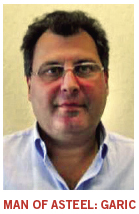In a Flash
From Fremont to Tunisia, AsteelFlash aims to be a worldwide Tier 2 EMS.
It was among the largest EMS mergers of the decade, but the timing – just a few days before Christmas 2007 – may well have distracted from the enormity of the event. On Dec. 20, Asteel announced its acquisition of Flash Electronics in an all-stock deal, forming an EMS company with more than $600 million in annual sales.
Today, Paris-based AsteelFlash (asteelflash.com) has 12 manufacturing locations on four continents, and continues to make the occasional strategic acquisition, having acquired MRP in the UK in 2008. Georges Garic, corporate vice president and general manager of America and Asia, spoke with Circuits Assembly’s Mike Buetow in July about the company’s strategic approach – and its atypical footprint.
CA: Asteel has 12 sites worldwide, but compared to some of the large EMS companies in the world, they are not in all the usual places. Do you see that changing at all over the next two years?
GG: Asteel and Flash Electronics created AFG in February 2008. Our strategy is to become a worldwide Tier 2. We want to differentiate ourselves by the proximity, the footprint, the technology and our supply chain.
We are planning to acquire something in Mexico, and on the East Coast in the US and in some other countries in Europe. The proximity [to customers]
is important.
CA: In some company literature, Asteel presents itself as a high-mix, low-volume company.
GG: When we analyzed the market, we saw all the Tier 1s merging and becoming bigger, and
customers were coming to us and complaining about service problems for the high-mix, low-volume markets. When it’s high-volume, low-mix, it’s easy to run with the Tier 1s. When it’s high-mix, it’s another story.
CA: Could you break down the percent of revenues from low-mix, high-volume vs. high-mix, low-volume?
GG: Today, high-mix, low-volume is about 60% to 70% of revenue.
CA: What is a typical lot size?
GG: One hundred to 200 boards would be a big batch.
CA: Break down Asteel’s end-markets by sales percentage.
In a FlashWe are trying to balance the markets: networking infrastructure, storage, industrial, RF, and lighting.
CA: Why are those ideal markets for the company today?
GG: It’s linked to our history and footprint. California is heavily in networking and storage. In Europe, it’s heavily industrial. So due to the history of the two companies, we are strong in those areas.
Other areas we are trying to develop are military/aero – we are now ITAR registered in our Fremont, CA, plant – and medical, so we can expand. We also are working on solar, which we group under industrial.
CA: Among your sites are two in Tunisia. Are there differences to manufacturing in North Africa vs. other locations?
GG: Tunisia is to Europe what Mexico is to North America. It is stable and low-cost. There are a lot of companies there from Europe: Spain, Germany, France, Italy. Among EMS companies however, none from the Tier 1 is there. After us, there are companies in the $20 million to $50 million range. There is a clear stability of costs that you don’t have in Eastern Europe. We saw all the costs in Eastern Europe skyrocket. Tunisia has stability in the wage rate and the exchange rate of the dinar to the euro. And it is one hour from Europe by plane.
CA: As of 2008, you had sales of $608 million. Where does that stand today?
GG: At the end of this year, we will be ahead of our 2008 revenue.
CA: Have you encountered problems with parts availability?
GG: Everyone has the problem. We have heat on lead times and prices. I don’t know when the end to this crisis will be. It started in the fourth quarter (2009); I think we will suffer through the end of this year. But we don’t see any more huge expansions of lead times.
Our backlog is clearly increased. I think there is a potential small bubble effect of this backlog. We are spending a lot of energy and have some negative heat because of prices.





